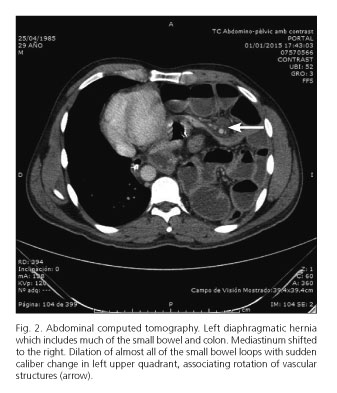Mi SciELO
Servicios Personalizados
Revista
Articulo
Indicadores
-
 Citado por SciELO
Citado por SciELO -
 Accesos
Accesos
Links relacionados
-
 Citado por Google
Citado por Google -
 Similares en
SciELO
Similares en
SciELO -
 Similares en Google
Similares en Google
Compartir
Revista Española de Enfermedades Digestivas
versión impresa ISSN 1130-0108
Rev. esp. enferm. dig. vol.108 no.4 Madrid abr. 2016
PICTURES IN DIGESTIVE PATHOLOGY
Mechanical intestinal obstruction secondary to congenital diaphragmatic hernia in an adult. Report of a case
Oclusión intestinal mecánica secundaria a hernia diafragmática congénita en un adulto. Presentación de un caso
Rodolfo Batista-Castillo, Alicia Martínez-Zavala, Gonzalo Galofré-Pujol, Yanina Gobbini and Juan Carlos Arias-Estévez
Department of General and Digestive Surgery. Hospital de Sant Joan Despi Moisès Broggi. Consorci Sanitari Integral. L'Hospitalet de Llobregat, Barcelona. Spain
Case Report
We present the case of a 29-years-old male without relevant medical history who presented to the emergency room with 4 days of epigastric pain associated to nausea and vomiting, postprandial fullness feeling and loss of appetite. A physical examination revealed hypophonesis on left chest; discrete abdominal distension, painful epigastric tenderness without peritonitis. The blood test showed discrete hyponatremia. Chest X-ray revealed fluid levels in the left hemithorax (Fig. 1). Computed tomography (CT) describing voluminous left diaphragmatic hernia including colon and dilated small bowel loops with abrupt change of gauge in the left upper quadrant (near the hernial orifice) with rotation of vascular structures (Figs. 2 and 3). Urgent surgical intervention was proposed; intraoperative findings: Left diaphragmatic defect containing stomach, colon and small bowel volvulus; release of adhesions, devolvulation of intestinal volvulus and reduction of hernia contents, defect closure with simple suture and prostheses Physiomesh® (Ethicon) were performed.
Discussion
Usually, diaphragmatic hernia occurs in pediatric patients with acute respiratory failure. In adults, most are asymptomatic incidental findings on imaging tests performed for other reasons. The clinical manifestations range from nonspecific symptoms to the strangulation of an intestinal loop. It may be suspected by chest radiography, being the CT the technique of choice for diagnosis. Surgical treatment is proposed (transabdominal or transthoracic access), even in asymptomatic patients. The laparoscopic approach is an excellent way to confirm the diagnosis; allowing an easy visualization of the hernial sac, repair an uncomplicated Morgagni's hernia and other conditions that are associated with it, such as hiatus hernia. The development of this minimally invasive surgical technique also gives the patient the benefit of fewer days of hospital stay and lower risk of complications in the short and long term.
Recommended References
1. Parra NM, Ortega SJ, Berríos SR, et al. Hernia diafragmática complicada con rotura de víscera hueca dentro de la cavidad torácica. Rev Chil Cir 2013;65:342-5. DOI: 10.4067/S0718-40262013000400010. [ Links ]
2. Robledo-Ogazón F, Vargas-Rivas A, Hernández-Ramírez DA, et al. Hernia diafragmática congénita en el adulto. Informe de un caso. Cir Cir 2008;76:61-4. [ Links ]
3. Arráez-Aybar LA, González-Gómez CC, Torres-García AJ. Morgagni-Larrey parasternal diaphragmatic hernia in the adult. Rev Esp Enferm Dig 2009;101:357-66. DOI: 10.4321/S1130-01082009000500009. [ Links ]
4. Rodríguez-Hermosa JA, Pujadasa M, Ruiza B, et al. Hernia diafragmática de Bochdalek en el adulto. Cir Esp 2004;76:191-4. DOI: 10.1016/S0009-739X(04)78962-9. [ Links ]











 texto en
texto en 




